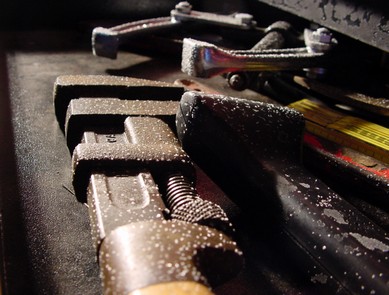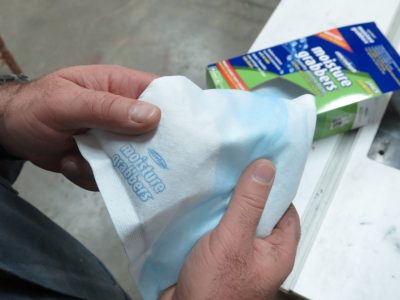 Q: My husband and I store power tools, hand tools and garden tools in our garage, and they’re getting quite rusty. I’m not sure why because they never get wet. What’s causing the rust and how can we stop it?
Q: My husband and I store power tools, hand tools and garden tools in our garage, and they’re getting quite rusty. I’m not sure why because they never get wet. What’s causing the rust and how can we stop it?A: Rust on tools stored in unheated sheds and garages is a common and constant problem, especially in climates with wide swings in temperature from summer to winter. The worst time for tool rust is in the spring, when warm weather rolls in quickly after a cold spell. The tools remain cold for a time while the air around them is warm and moist. This leads to frost and condensation developing on tool surfaces, just like beads of condensation build up on the outside of a cold drinking glass in the summer. As water appears on your tools out of nowhere it triggers rust.
 Your first line of defense is to store as many of your hand tools as possible in a wooden box with a sealed lid. Wood tends to absorb excess moisture, keeping it away from metal tools. You’ll enjoy even better results if you also keep something inside the box to absorb moisture. The best I know of right now is a product called Moisture Grabbers. It comes as a cloth-type bag with moisture absorbing beads inside. Moisture Grabbers come in different sizes, some ideal for toolboxes and others large enough to dehumidify small rooms.
Your first line of defense is to store as many of your hand tools as possible in a wooden box with a sealed lid. Wood tends to absorb excess moisture, keeping it away from metal tools. You’ll enjoy even better results if you also keep something inside the box to absorb moisture. The best I know of right now is a product called Moisture Grabbers. It comes as a cloth-type bag with moisture absorbing beads inside. Moisture Grabbers come in different sizes, some ideal for toolboxes and others large enough to dehumidify small rooms.
For large tools that must be left out in the open, you need to protect all rustable surfaces with a coating. The trick is to make this job as quick and easy as possible or you simply won’t do it. Normally I try not to use products in aerosol spray cans because they’re expensive for the amount of product they contain, but protecting tools from rust is an exception. I used to use WD-40 for this job, but it’s too thin and it evaporates too quickly. These days I protect my tools with the same kind of rust protection I use on my truck. I buy either Rust Check or Krown in spray cans, then apply it to anything that threatens to rust. It takes just a few seconds to lightly coat most items. And even if you don’t coat everything, the liquid creeps over time to cover entire surfaces.